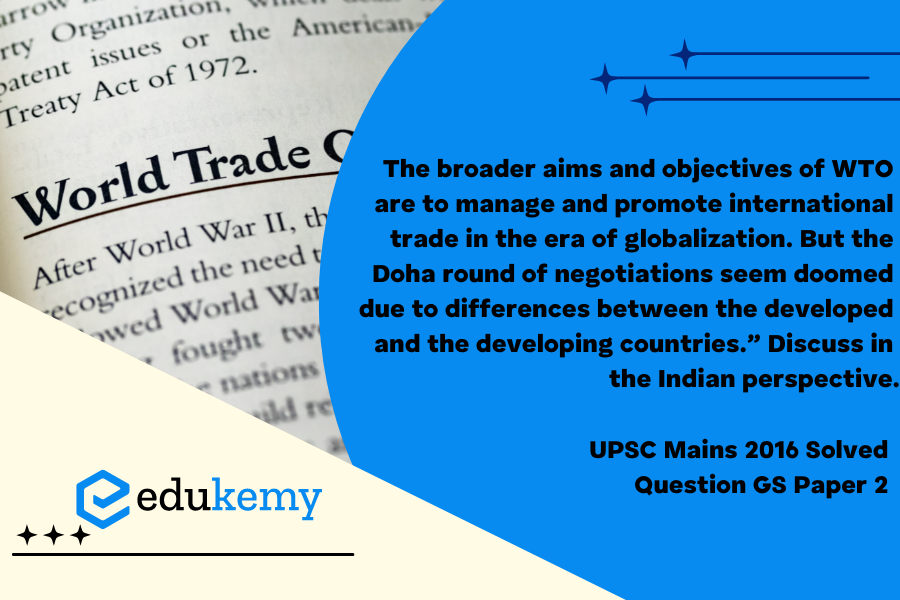The World Trade Organization (WTO) stands as a pivotal institution in the realm of global commerce, with overarching objectives centered on the management and promotion of international trade within the context of an increasingly interconnected world marked by globalization. However, the Doha Round of negotiations, a critical phase in the WTO’s pursuit of equitable and inclusive trade agreements, appears to be ensnared in a quagmire of disparities between developed and developing nations. This dilemma is particularly pronounced when viewed through the lens of the Indian perspective. As a burgeoning economic powerhouse with a diverse socio-economic landscape, India finds itself at the crossroads of these negotiations, grappling with the intricacies of balancing its developmental aspirations with the demands of a global trade framework. The challenges emanate from the asymmetries in economic capacities and policy priorities between developed nations, often pushing for liberalization, and developing economies, seeking space for their growth trajectories. In this context, issues related to agriculture, intellectual property, and market access become contentious points, mirroring the struggle for a fair and just international trade order. This essay delves into the intricacies of these challenges, analyzing the implications for India and highlighting the intricate dance between national interests and the broader global objectives of the WTO in the context of the stalled Doha negotiations.
Tag: Important International institutions, agencies and fora- their structure, mandate.
Contents
Decoding the Question:
- In the Introduction, try to briefly write about WTO and its aims.
- In Body,
- Briefly write about Doha round negotiations and various issues with it.
- Discuss Indian perspective with the negotiations.
- In Conclusion, try to suggest a way forward.
Answer:
The World Trade Organization (WTO) emerged after rigorous negotiations, relying on consensus for decision-making. As the sole global organization governing trade rules between nations, its aim is to facilitate smooth, predictable, and free trade. Operating on a multilateral platform, the WTO enables smaller and developing countries to negotiate international trade matters, fostering integration of trade and development.
The main objectives are:
- Achieving progressive liberalization of trade in services.
- Ensuring flexibilities for developing countries, with special priority to be given to least-developed countries.
- Respecting the needs of developing countries.
The Doha round held in 2001 was of particular significance because of its equitable nature. The developing and least developed countries were given special differential treatment . The round came to be known as the Doha development round and was seen as a step towards development rather than just trade. The significant points were:
- To keep the needs of developing countries at the heart of the talks
- Less than full reciprocity on Non-Agricultural Market Goods (NAMA)
- A clear mandate for liberalization in Agricultural Products
- Flexibility in liberalization for developing countries
- The agreement should cover all aspects of trade in integral manners and signed as a “single undertaking”
Doha Negotiations and Differences among Developed and Developing Countries:
- The Doha round of negotiations of WTO was officially launched at the WTO’s Fourth Ministerial Conference in Doha, Qatar 2001, to provide the mandate for the negotiations on agriculture, services, and an intellectual property topic and lower trade barriers around the world to facilitate global trade.
- It aims to achieve reform in the international trading system through the introduction of lower trade barriers and revised trade rules.
- The negotiations have remained stalled since 2008, primarily over the issue of huge trade-distorting subsidies being given to farmers by the rich countries.

- The developing countries argued that the rules and regulations are more in favor of the developed or industrialized countries. They are demanding more favorable market conditions and trade concessions from developed countries.
- On the other hand, the developed countries argue that the developing economies don’t comply with their demands for near-zero tariffs in agriculture and services.
Indian perspective
- India has also been seeking concrete work plans on a special safeguard mechanism for developing countries to protect their farmers from a spurt in imports and on a permanent solution to the issue of its official grain procurement and food security in the country, as agreed on in the Bali ministerial.
- India faces huge food security challenges; it is home to one-fourth of all undernourished people worldwide.
- India is demanding a broad exemption for public stockholding programs from the definition of trade-distorting support. It wants to move these programs to the green box and aims that the exemption from any legal challenge would last until a permanent solution is found to the food security concerns of developing countries.
- India agreed to phase out its agriculture export subsidies (including flexibilities allowed in transport and marketing) by 2023 in WTO’s ministerial meeting in Nairobi.
The WTO’s reputation suffered due to the Doha round’s failure. Countries are increasingly favoring faster, bilateral and multilateral treaties. The US crafted the Trans-Pacific Partnership and Transatlantic Partnership, while China, India, and Japan negotiated the Regional Comprehensive Economic Partnership with ASEAN. Despite these efforts, a global architecture under the WTO remains essential. Nations must cooperate and compromise to establish principles for fair global trade.
In case you still have your doubts, contact us on 9811333901.
For UPSC Prelims Resources, Click here
For Daily Updates and Study Material:
Join our Telegram Channel – Edukemy for IAS
- 1. Learn through Videos – here
- 2. Be Exam Ready by Practicing Daily MCQs – here
- 3. Daily Newsletter – Get all your Current Affairs Covered – here
- 4. Mains Answer Writing Practice – here


